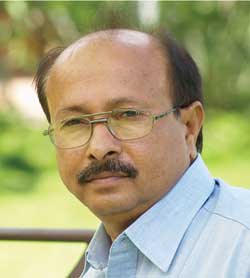The recent assessment of Thar Desert, focusing on crop production -both cash and grains- and availability of food stock as well as the status of usual sources of protein supplements revealed that the government is yet to understand the multifaceted issues to find solutions.
The recent assessment of Thar Desert, focusing on crop production -both cash and grains- and availability of food stock as well as the status of usual sources of protein supplements revealed that the government is yet to understand the multifaceted issues to find solutions.
The traditional sources of retaining nutrients for the people of Thar are milk, butter, lassi, meat, eggs, poultry, grains and vegetables, both cultivated and naturally produced.
 Dr Sono Khangharani, a development activist, who keeps a close eye on the situation in Thar, said there was no concept of producing milk for markets in the past. “Livestock farmers used to give milk and lassi generously to neighbouring people, who were mostly poor, to support them,” Khangharani said. “Lassi was a common diet for the poor, who did not have milk sources a few years ago and they lived happily. But now the milk goes to the market, hence there is no practice of producing butter and distributing lassi among the neighbours."
Dr Sono Khangharani, a development activist, who keeps a close eye on the situation in Thar, said there was no concept of producing milk for markets in the past. “Livestock farmers used to give milk and lassi generously to neighbouring people, who were mostly poor, to support them,” Khangharani said. “Lassi was a common diet for the poor, who did not have milk sources a few years ago and they lived happily. But now the milk goes to the market, hence there is no practice of producing butter and distributing lassi among the neighbours."
Likewise, he said the practice of maintaining backyard poultry farms has also declined, especially among the socially termed ‘low-caste’ Hindus. Earlier, such farms were a major source of protein supplements for children who consumed eggs and chicken. Khangharani says, “These families now believe eating eggs and chicken is prohibited by their religion.”
The issue of malnutrition is further compounded by the non-affordability of vegetables among the poor, who mostly rely on natural vegetables, which too are scarce in the sand dunes.
Presently, there is hue and cry due to malnutrition and deaths of minors in the sand dunes, and hospitals in drought-stricken towns of the Tharparkar district have not responded suitably, since the government authorities are still clueless about the exact nature of the problem.
For example, the area this year failed to produce pearl millet, the major food source of local communities. It was because the sowing of pearl millet was delayed due to changing monsoon pattern and farmers were unable to produce this main crop.
The people residing on the sand dunes near the famous Wango Pattan, the gateway to Thar, bordering Badin and Tharparkar have a lot to say about the situation and made suggestions for the government authorities and those interested to help people in the desert.
According to the area elders, production of mostly guar stood at only around 30 percent over the last year due to less rains in 2015, which the people have kept for the market.
Since the main crop in Thar is pearl millet, which farmers failed to produce due to delayed monsoon, there is no food stock for people and fodder for animals. This is also forcing many people to migrate earlier than usual, especially those having livestock.
Though there is no exact data of livestock in the desert, it is assumed that Thar is home to six million animals -60 percent big and 40 percent small. Traditionally the practice was that the majority of big animals, like cows, camels and donkeys would be moved to barrage areas at the end of April and May. But this year due to bad crop and unavailability of fodder, the community may leave their abodes earlier to reach barrage areas.
This seasonal migration of people is also connected to wheat harvest. Khangharani said the workforce frequently communicates with the landlords, who arrange trucks for shifting them to desired destinations. The landlords also hire many of these migrant families, so migrating to barrage areas also gives an opportunity to earn.
However, early migration has many complications and increase dependency on traditional routes of nomadic families.
Livestock farmers may travel with hundreds of cattle by traditional routes, going from one place to another.
“They stay with their relatives along the route, where they sell milk and meat for their survival,” Khangharani said.
These livestock farmers return back at the onset of monsoon, mostly in July. In case of harsh weather and fear of unavailability of fodder for animals, males stay back with animals and return when monsoon begins in their areas.
Khangharani calls a seasonal calendar a must for determining rains pattern, crop sowing seasons, preferred grains/crops, time of migration and the stress-season - when lack of nutrition may affect children and provision of food to the poor - to address the multifaceted problems of Thar.
He said there should be a comprehensive programme similar to Benazir Income Support Programme, which provides cash to the poor so they maintain their life at the marginalised sand dunes.
When everything, including milk, lassi, vegetable, eggs and chicken are for the market, the poor should have access to these items to retain protein to avoid any such situation.
He said Thar needs a comprehensive health package, including nutrition, prevention, and a tertiary care hospital, effective BHUs and surveillance. It needs leakage-free quality medicine supply and free medical care by experts, who have access to remote villages to help the marginalised families,” Khangharani.
The writer is a staff member